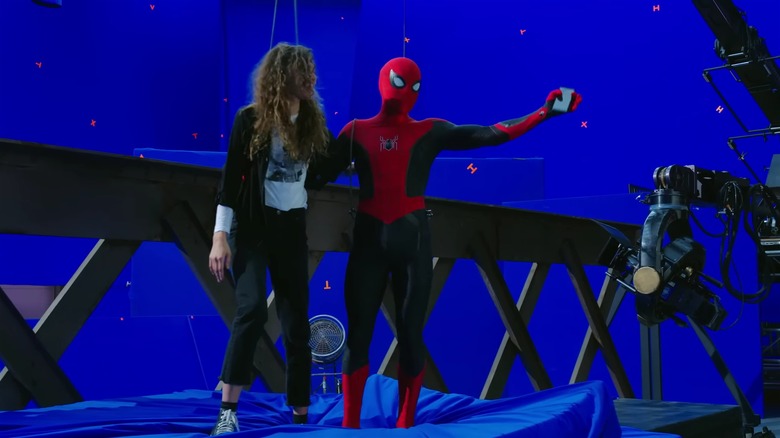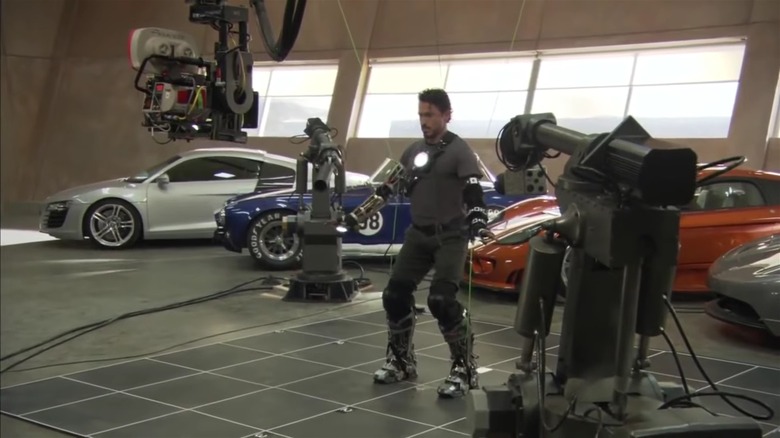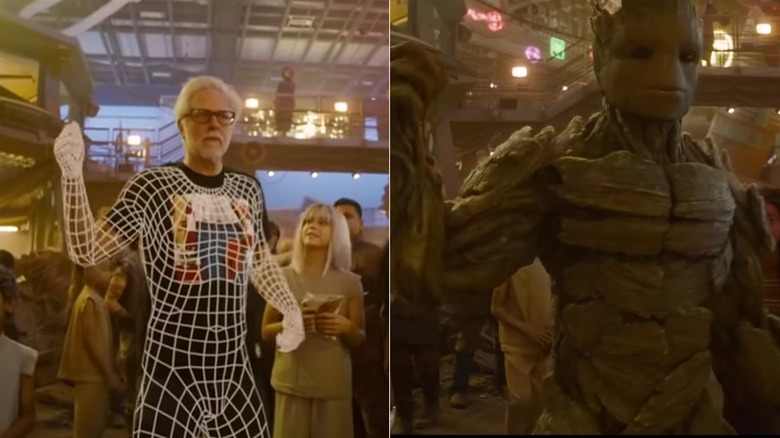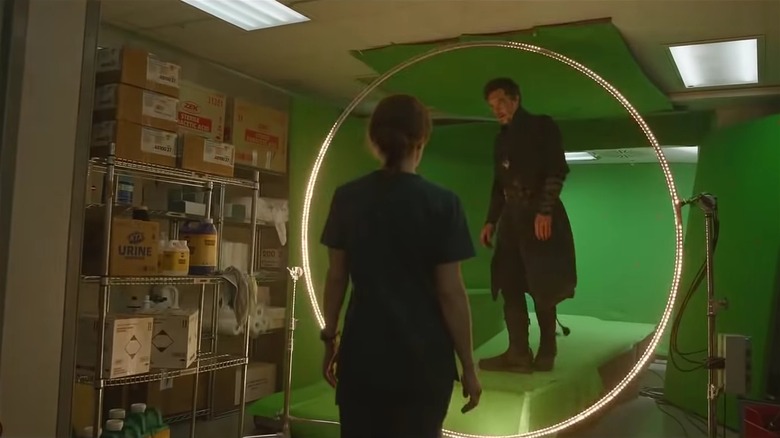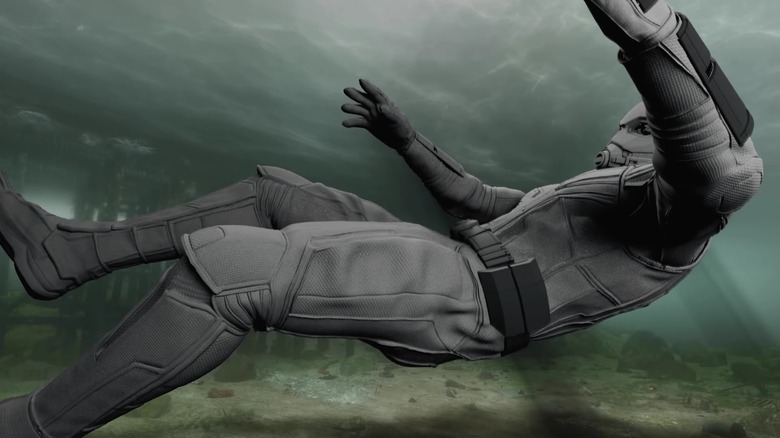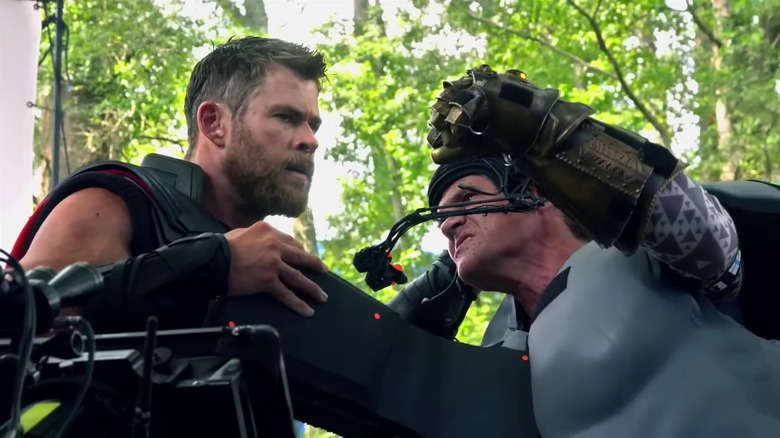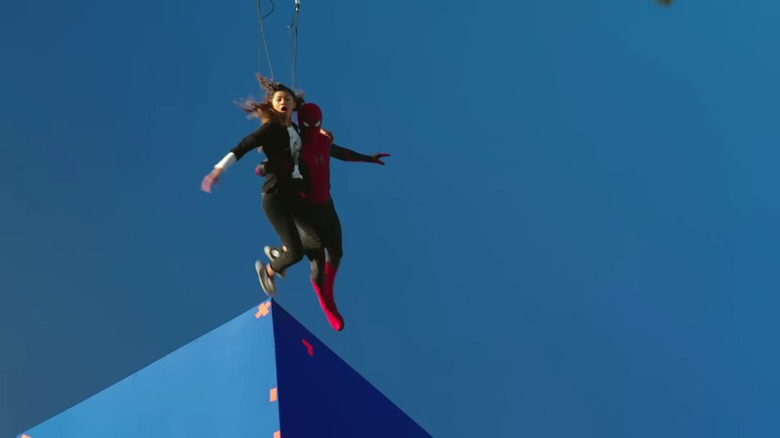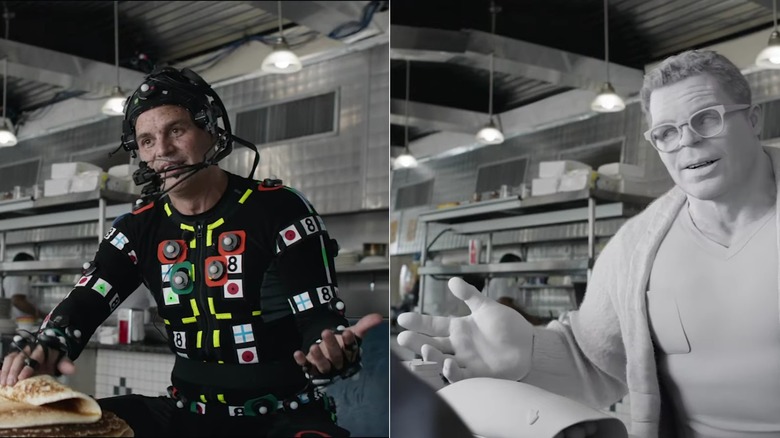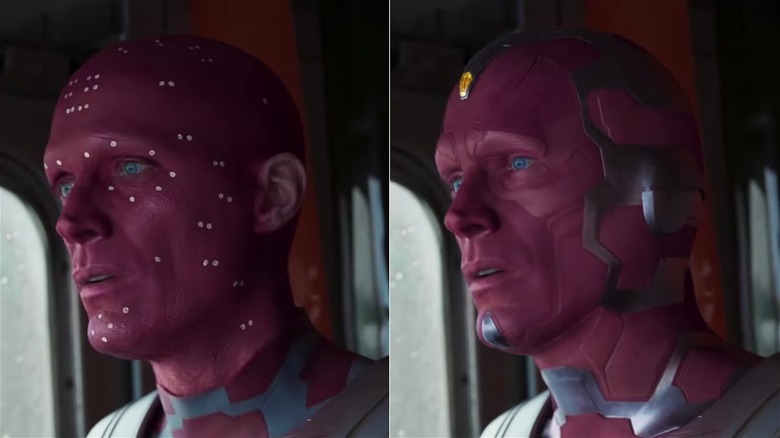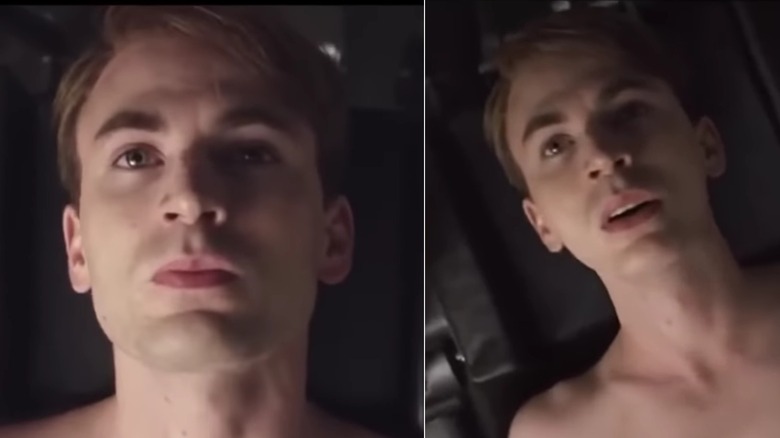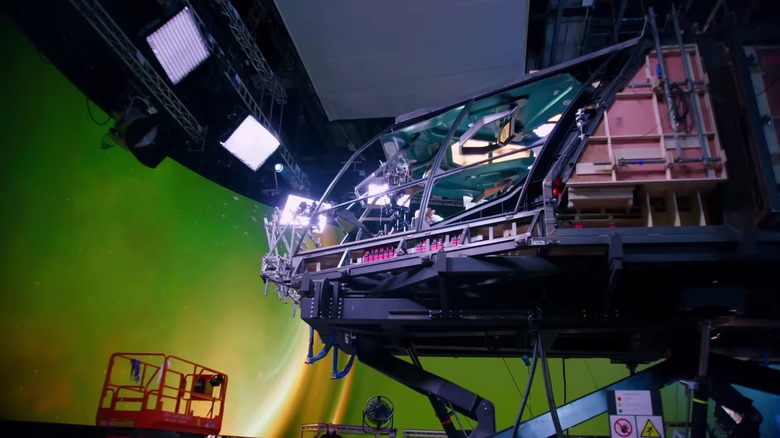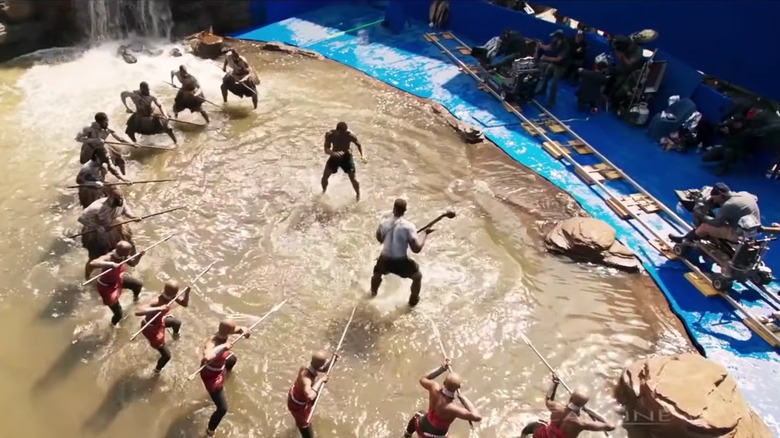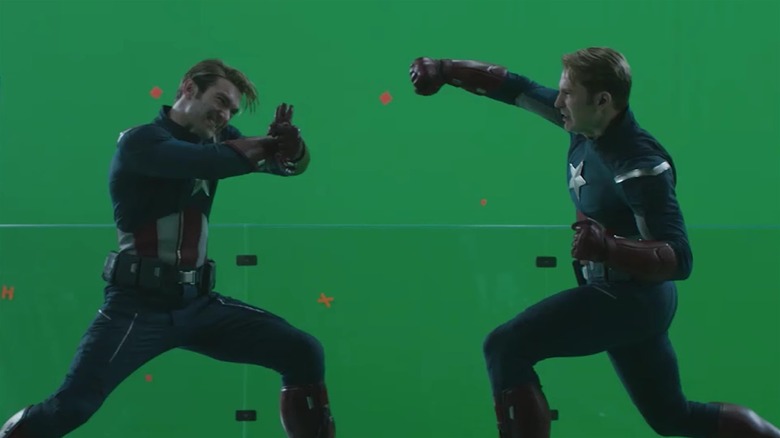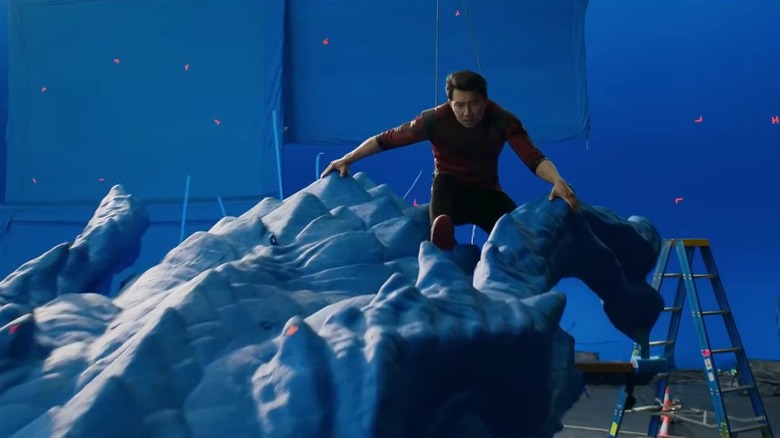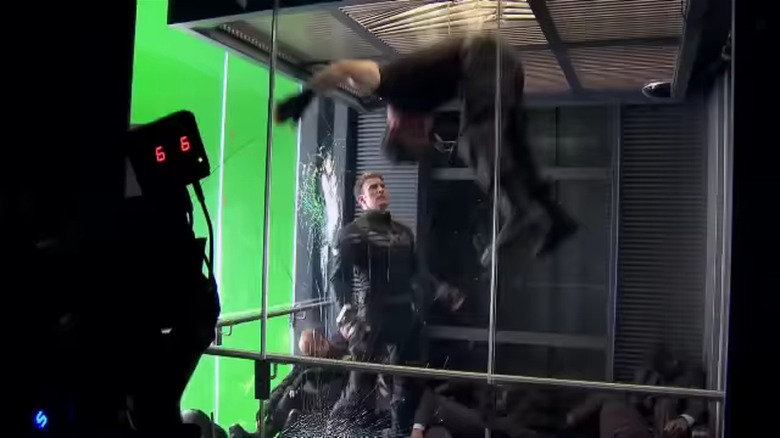What Marvel Movies Look Like Before Special Effects
Fans love the Marvel Cinematic Universe for many reasons, including the franchise's eclectic characters, its engagement with decades of comic book lore, and its willingness to flood the market with crossovers and surprise easter eggs. If Marvel films are nothing else, they are visual spectacles, a reason to go to the movie theater and see fantastical stories play out on the biggest screens possible. The franchise's visual effects are a big draw, allowing various Marvel filmmakers to create worlds and characters that wouldn't always be possible to shoot in the real world.
In fact, Marvel's intense process for developing visual effects has occasionally drawn criticism, both from VFX artists and the filmmakers at the helm of these movies. Director James Gunn, who made the "Guardians of the Galaxy" films, told Gizmodo that Marvel's VFX demands were occasionally difficult to work with, because not everything gets correctly worked out in pre-planning stages. Still, he acknowledged that Marvel gets results. "I've seen them turn bad movies into okay movies, okay movies into good movies, and good movies into great movies," he said. "They give it whatever it needs to make it as good as it can possibly be until the 11th hour."
Because there's so much chatter about Marvel's visual effects, the studio often releases featurettes that show fans what various shots, creatures, environments, and more look like at various stages of the VFX process, thereby letting us see what Marvel movies look like before special effects. Let's take a look!
Robert Downey Jr.'s Iron Man suit is made of VFX
Visual effects have been part of the Marvel Cinematic Universe since the beginning. Case in point: the Iron Man suit in 2008's "Iron Man," which in many shots is entirely digital. While a lot of VFX shots require careful pre-planning, "Iron Man" director Jon Favreau told Variety that he allowed Robert Downey Jr. to improvise, working out the visual effects after the fact. "It was all discovered on the day," Favreau explained of the scene where Tony Stark first tries to fly. Visual effects supervisor John Nelson added, "He's such a gifted improviser. He affected everything."
A 2008 behind-the-scenes featurette from Industrial Light & Magic shows Downey filming the sequence. To prepare for more realistic visual effects considering the Iron Man suit's propulsion system, they developed a new form of wire rig that supported Downey by his feet. "You can see the dynamics, as he's flying through the air, feels much truer to what the real physics of flying being powered by your feet would be," Favreau explained, showing that the best VFX are often a combination of practical and digital.
Overall, Favreau distrusted VFX. Once, he told the special effects team that the Iron Man suit didn't look lifelike enough, only to be told that the shot was of a practical suit from set instead of a computer-generated one. "When I knew they had me fooled, I knew it was OK to be in the film," he recalled.
James Gunn and his brother Sean performed motion capture for Guardians of the Galaxy Vol. 3
The Guardians of the Galaxy function like a family, from the parental influences of Star Lord (Chris Pratt) and Gamora (Zoe Saldana) to the bumbling siblings of Rocket (voiced by Bradley Cooper) and Drax (Dave Bautista). That dynamic is especially evident in the case of Groot (voiced by Vin Diesel), a tree-like creature cut down to sapling size; he became Baby Groot at the end of the first film, then steadily aged through teen years into adulthood again.
The "Guardians of the Galaxy" movies are a family affair behind-the-scenes, too, with director James Gunn inviting his brother Sean Gunn to set to do motion capture for Rocket Raccoon. For "Guardians of the Galaxy Vol. 3," it was an especially emotional moment for the two brothers to be together on set. "In the moment we were shooting the wide shot and dancing toward each other, it was surreal and beautiful and wonderful," the director told The New York Times of the scene, which was set to "Dog Days Are Over."
A VFX reel for the film by visual effects studio Framestore shows both Gunn brothers on set filming the sequence. At this point in the Marvel Cinematic Universe, motion capture technology has evolved so much that the Gunns aren't even wearing suits while performing the scene. Instead, they went at it freestyle, and Framestore digitally painted over their bodies, tracking their shapes after the fact.
Dr. Strange's portals are green screen
Dr. Strange (Benedict Cumberbatch) has a number of superpowers. In addition to wearing a magical cape (or cloak), Strange can look into alternate futures, perform arcane magic with his hands, and open portals to other locations. These portals often involve merging glimpses of two different sets into one shot, meaning they present a challenge to filmmakers.
In a reel of visual effects created for the first "Doctor Strange" by VFX studio Framestore, we can see the way the portal shots were crafted on set. To indicate where the portal itself would be located, the filmmakers set up a circular ring of LED lights to represent the glowing door to another world. Anything visible through that circle got covered with some strategically-placed green screen, to be digitally replaced after the fact. In addition, CGI sparks were later added all around the circular ring, giving the portals their signature look.
Production VFX supervisor Stephane Ceretti told Art of VFX that those sparks are actually crucial to the whole process, a mandate from director Scott Derrickson that the magic should be made of recognizable, real-world elements. Ceretti explained, "We made sure all our sparks would follow perfect simulations and details, so the audience could completely relate to them as being real."
Ant-Man's size-shifting required considerable VFX work
Sometimes, especially when scenes and shots are created entirely with visual effects, more work goes into the process than we ever actually see on screen. That was the case in "Ant-Man and The Wasp," as is evident in a behind-the-scenes featurette for Wired. After all, the movie is about a man who can instantly shift his size; in the film, he gets incredibly small and also becomes incredibly large. That shift in perspective required numerous shots that were created entirely digitally, and the filmmakers' dedication to realism meant they did a lot of layering that isn't always visible in the final shot.
For example, one sequence sees a giant Ant-Man sink into the waters off San Francisco. Danielle Costa, Vice President of Visual Effects at Marvel Studios, broke it down, noting that the Pacific Ocean near San Francisco is pretty tough to see through. "What I think is funny about that particular shot is how much detail that they built, how much of the Bay they built, how much of his suit and how much they rendered and all of that," she said. "And then in the end, they kind of did a wash, deleting all of that great detail, because you wanted to give it the, you know, realistic quality of feeling like the murky Pacific Ocean."
Josh Brolin's Thanos look was created by VFX
While many of the characters in the Marvel Cinematic Universe are human, or at least human-like, a number are created almost entirely through CGI. That includes Thanos (Josh Brolin), the main villain of both "Avengers: Infinity War" and "Avengers: Endgame." He's a huge purple Titan, and that meant his appearance needed to strike fear into the hearts of not just Marvel fans but the in-universe superheroes themselves.
When it came to giving the other actors something to work with, Brolin was crucially on set during filming, including at the climactic "Snap" sequence at the end of "Infinity War." According to The Hollywood Reporter, he often wore a backpack that had a pole extended upwards to indicate where the other actors should look. His on-set performance was captured by a motion-tracking camera, and then effects artists from both Weta Digital and Digital Domain developed the look of Thanos around that performance. This involved a combination of machine-learning, CG doubles of both Thanos and Brolin, and animators crafting images by hand.
Visual Effects Supervisor Kelly Port told The Verge that an extensive testing process with Brolin was crucial in getting him to modulate his performance for the VFX to come. "What he saw in the test was that even in a very casual performance, a lot of subtle facial details were coming through," she recalled. "I think there was a huge sigh of relief in the room, that in fact, we could pull this off."
Spider-Man: No Way Home required a lot of wire work
No Marvel Cinematic Universe character moves quite like Spider-Man does, swinging on webs through cityscapes. That character presents a unique set of challenges for the visual effects artists behind the "Spider-Man" films, including the 2021 installment "Spider-Man: No Way Home." A behind-the-scenes featurette shared to Spider-Man's official YouTube account showed Tom Holland in costume, performing a number of stunts on wires in front of blue screens. Those environments and wires then get digitally swapped out, giving us the impression that Spidey is slinging webs all around New York City.
Action choreographer George Cottle explained that the wires were particularly important in developing the movie's action sequences. "The hard thing for wires ... is, we had to put at some points six, seven, even eight characters on wires at the same time, and they all had to be very unique to their own character," he recalled. In other words, Doc Ock (Alfred Molina) had a different wire setup than The Green Goblin (Willem Dafoe), whose wires moved differently than Spider-Man's, and so on.
Zendaya, who plays M.J. in the films, noted that there were plenty of people looking out for them on set while they performed wire stunts. "We have an incredible team of people who make sure that we are safe," she said. "It's like, when ever in the world will I be able to experience this stuff?"
Mark Ruffalo does The Hulk's motion-capture on set
Like Josh Brolin's performance as Thanos, Mark Ruffalo was actually on set when he portrayed Bruce Banner's alter ego Hulk. A behind-the-scenes featurette from Marvel for "Avengers: Endgame" depicts Ruffalo performing in a motion-capture suit, his face covered in tracking dots and his body enveloped in patches and balls that could later be used to recreate his body language digitally.
In the featurette, visual effects supervisor Dan DeLeeuw explained that Marvel tries to use visual effects to complement the performances they get from their actors. "It's that partnership," he said. Ruffalo brought decades of acting experience to the character, and the VFX team needed to meet that challenge. "You want to be in a place that you have the artistry and the technology at a place that can actually incorporate that into the final visual effect," he said.
For the record, Ruffalo isn't really a fan of having to act like this. He's spoken out against the process several times, including when he reprised the Hulk in the Disney+ series "She-Hulk: Attorney at Law." Ruffalo told Metro UK, "I know how to act inside that bubble, which can be a little dehumanizing at times. Sometimes the technology starts to take the front seat when it should really be the performance and how we bring our humanity to that very austere environment."
Vision is a combination of makeup and VFX
Like many other VFX-enhanced creations in the Marvel Cinematic Universe, Vision (Paul Bettany) is developed through an on-set application of makeup and prosthetics that is later enhanced by CGI overlays. A featurette for Disney+ show "WandaVision" developed by special effects house SSVFX shows the process, which begins with Bettany actually on set. He wears purple makeup and has his face covered in motion-tracking dots. Those are then painted over digitally, and various layers add futuristic detail to Vision's face, including the iconic yellow Mind Stone that sits in the center of his forehead.
A special effects studio called MARZ also worked on Vision's look for the show. VFX supervisor Ryan Freer told Gizmodo that when all was said and done, the effect should be seamless, making it almost impossible to tell that you're looking at a superhero made largely out of CGI. He recalled scrolling through Reddit after the show debuted, seeing people trying to guess how the show's special effects were pulled off. "I went all the way down through all the boards and nobody really nailed it," he said. "There was maybe one person [who] said 'I heard they overlay visual effects on top of Vision or something,' but...yeah. It's the art of making art that no one notices."
Skinny Steve Rogers didn't require Chris Evans to lose weight
Many modern Marvel movies are full of eye-popping CGI, but when the franchise was still getting off the ground, things seemed more subtle. One great example of the underplayed visual effects of those first few Marvel movies is skinny Steve Rogers (Chris Evans). Before he takes the Super Soldier serum that bulks him up into the brawny bodybuilder we know and love, Cap was scrawny. Evans wasn't required to lose a bunch of weight for these scenes in "Captain America: The First Avenger." Instead, he acted normally, and then with an assist from a body double, Marvel used VFX to shave off the pounds.
A Marvel featurette (via JoBlo) about the character lays out how everything came together. "We knew that the movie wouldn't work if you didn't buy Skinny Steve at the top," producer Kevin Feige explains in the video. "If that looked fake, if that didn't feel right, you would lose it entirely." Instead, they developed a three-pronged shooting process: Evans' performance naturally, the performance of a body double, and a CGI version of the character, which mapped Evans' face onto the double.
Eventually, they had a rough cut of the transformation scene. People asked Feige how they added the muscles, and he responded, "That's not the effect. The effect is the skinny version. ... That is kind of when we all looked at each other and went, 'It's gonna work.'"
The Marvels was shot on the Volume
Plenty of Marvel movies have been shot largely in front of green screens, allowing visual effects artists to go back after filming and add just about anything in the background. "The Marvels," on the other hand, was shot on The Volume, an immersive production screen that allows filmmakers to shoot with the virtual effects already present on set. Iman Vellani, who plays Kamala Khan/Ms. Marvel, said in a behind-the-scenes featurette from Marvel, "The Volume screens are just the greatest thing ever, and you can actually see what you're supposed to see and not just a green screen, so that's always very, very helpful."
Director of photography Sean Bobbitt explained that this technology was especially useful in filming the sequences that take place on the spaceship. "When you look out every window of the spacecraft as we're flying along, there is something happening," he said. Visual effects supervisor Tara DeMarco pointed out what that meant for the actors on set. "We actually get to drift past a nebula and jump through a wormhole in a way that I never thought we'd be able to do on a set," she said.
Black Panther's Warrior Falls had only CGI water
In "Black Panther," King T'Challa (Chadwick Boseman) rules over Wakanda, a kingdom in Africa untouched by centuries of colonialism. Unfortunately, no such kingdom actually exists, meaning it had to be created entirely for the film. Many wide shots showing the majesty of the kingdom at large are entirely CGI. Other environments, such as Warrior Falls — important site of a brutal battle for the throne — were developed using a combination of practical sets and VFX.
VFX supervisor Geoffrey Baumann told The Hollywood Reporter that one pool of waterfalls was built on a set in Atlanta. The finished location, built up with CGI, contained 102 separate waterfalls, each with their own characteristics, and each demanded the VFX team run "unique simulations that required a bunch of time and render power."
A behind-the-scenes featurette released by Marvel shows the process, including the way crew members were digitally painted out and crowds of extras digitally painted in. To achieve photorealistic digital water, Marvel turned to ScanlineVFX, a company known for doing exactly that. In an interview with Chaos, CG supervisor Ioan Boieriu explained that they initially left in some actual water, but they wound up replacing everything with CGI water instead. "We had to introduce more details into secondary elements like realistic ripples from splashes," he recalled. Baumann told The Hollywood Reporter that this mandate came down from the director. He said, "Ryan wanted that sense of danger that if you fell, you could get washed over the edge."
Captain America vs. Captain America fight in Avengers: Endgame
Thanks to the timeline-twisting shenanigans of "Avengers: Endgame," Captain America (Chris Evans) manages to brawl with none other than himself. On an episode of Marvel's "Earth's Mightiest Show," visual effects supervisor Dan DeLeeuw broke down how the iconic fight sequence came together. He explained that the fight was filmed with stunt doubles, and then Evans came in and acted out each side of his coverage.
However, when they began to screen the movie for test audiences, they realized that the fight was missing something. "Originally, we shot it without the cowl," he recalled, referring to Cap's headgear. "People were losing track of which Cap was which." To solve the problem, visual effects artists went back in and added a CGI helmet overtop of the older/future Captain America.
The fight's environment, too, was created entirely in post-production. The fisticuffs were filmed on a green screen, and then VFX artists created the virtual skyscraper surrounding the actors from scratch. They set-dressed the virtual offices, developed reflections in glass, lit the windows, and more, and then they realized it was just too much to look at. "We ended up having to go in and just adding a little more atmosphere, kind of cheating the depth of field a little bit, just to kind of pull some of the detail out that we had put into it," he said, "so there wasn't as much visual information going into your eyes."
Shang Chi's Great Protector dragon was done on blue screen
In "Shang-Chi And The Legend of the Ten Rings," the titular superhero (played by Simu Liu) meets a dragon called The Great Protector. The film builds to a climactic showdown between The Great Protector and the Dweller-In-Darkness, and it even includes a sequence where Shang-Chi rides the dragon.
Crafting the creature for the screen required the collaboration of a number of visual effects studios, including Weta Digital. One of the biggest challenges in bringing The Great Protector to life was the dragon's gorgeous scale pattern, which VFX supervisor Sean Walker told ComicBook.com was shepherded by one lone VFX artist. "It almost killed them, but yes, we did have one hand place 8,000 scales on the dragon," he said. "He actually created the initial sculpt, and so he wanted to look after it as a whole ... And he hand-modeled every single one of those scales."
A behind-the-scenes featurette from Marvel (via JoBlo) for the film revealed how the crew melded the meticulously-designed digital dragon with on-set effects. In some shots, Liu is visible riding a giant blue rig, which was then edited and replaced by the digital build. SFX supervisor Dan Oliver told CinemaBlend, "That piece of dragon was on a six-axis gimbal so we could make that dragon head move and sway and go up and down and basically fly through the air. So we put some wind on them and some water spray and it's like we're basically there."
Behind the scenes of the elevator fight in Captain America: The Winter Soldier
One of the most memorable action sequences in the whole Marvel Cinematic Universe is the close-quarters elevator fight in "Captain America: The Winter Soldier." Cap (Chris Evans) finds himself in a small glass elevator surrounded by goons, and he manages to take them all down before the doors open back up. It's a marvel of fight choreography, no pun intended, but the sequence had another trick up its sleeve, too. The elevator itself was a visual effect, meaning they didn't have to fit the camera in that same small space where Cap was busy making swift work of some bad guys.
A behind-the-scenes featurette from Marvel shows that the skeleton of the elevator was constructed on a green screen soundstage, allowing walls and glass panes to be removed in order to get the camera close to the action. "We took seven days to shoot that one scene in the elevator," revealed actor Frank Grillo. It was the first scene shot for the film, and it required weeks of rehearsal to get the fight choreography down. They built a mock elevator and rehearsed in it while filming a "video viz," which was shot and edited just like the final product would be. That allowed them to perfect the camera movements and locations of various elements in the physical space, work which then transferred to filming on the green-screen stage. Ultimately, Evans concluded, "That scene couldn't have gone better."
